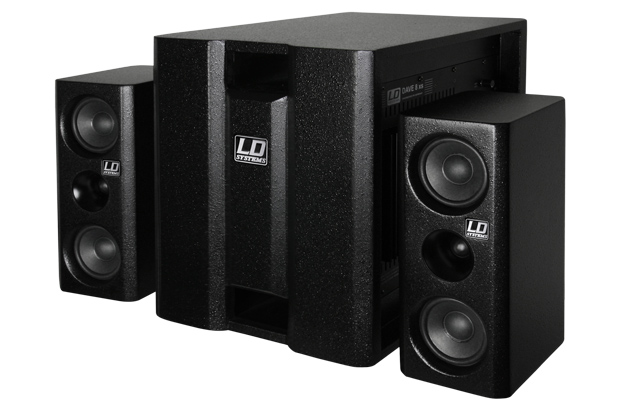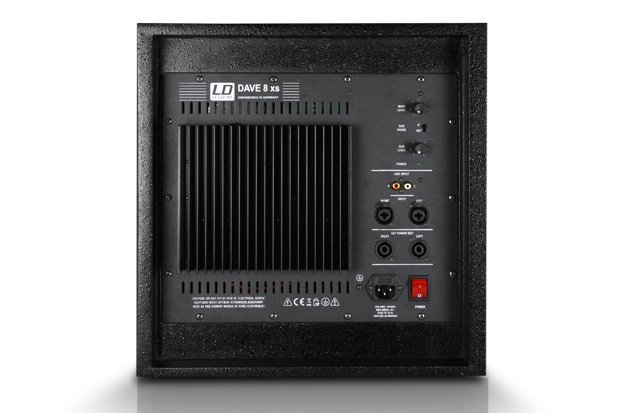LD Systems DAVE8XS – Test Report by delamar.de
 In this test report about the LD Systems DAVE8XS we will try to define for which applications this 2.1 multimedia system really qualifies. Can it take the hard demands of a mobile PA system life or is it rather adapted as a home monitoring system? The answer is here below.
In this test report about the LD Systems DAVE8XS we will try to define for which applications this 2.1 multimedia system really qualifies. Can it take the hard demands of a mobile PA system life or is it rather adapted as a home monitoring system? The answer is here below.
What is it?
The LD Systems DAVE8XS multimedia system consists of two satellites and a subwoofer. The subwoofer has an 8-inch driver; the satellites each have two 4-inch drivers for the mids and one 1-inch driver for the treble. At maximum volume, the system draws 350 watts of mains power, of which 150 watts are distributed to the subwoofer and 2 x 100 watts to the satellites.
The subwoofer, which also houses the electronics, has RCA and balanced XLR/Jack combo inputs. The satellites are passive.
According to the manufacturer, the system is suitable for various applications and is portable. We will see later just how portable it is. The specified applications encompass home recording, monitoring for DJs or keyboard players, and use as a PA for small events or in bars. The system is available in black and in white version. Workmanship & scope of delivery
Dave, as the multimedia system is now exclusively referred to by our editorial staff, comes in a large carton that contains the satellites and the subwoofer. The package also includes a power cord, two 3/8″ adapters for mounting the satellites on stands, and a user manual. It does not include two Speakon cables for connecting the satellites to the amplifier. If you do not already own these, they must be purchased separately. The satellites do not have any alternative connectors.
The cabinets leave a solid impression – not only in terms of weight. They are constructed of 15-mm MDF panels for the subwoofer and 12-mm panels for the satellites. The structured coating (a type of wet effect) seems to be extremely durable. On the whole, the level of workmanship is outstanding.
The position of the control panel with the connectors is unusual. It is not located on the back of the subwoofer as usual, but on the side instead. The cooling element and the various connectors, switches and knobs are all on the right side of the subwoofer when it is viewed from the front. In any case, this enables you to position the subwoofer with the back flush against a wall if you so choose.
The subwoofer, which measures 352 x 430 x 434 mm, houses a Class-A/B power amplifier that is cooled by the side-mounted cooling element. The cooling system is passive, so there are no fans or associated noise. However, LD Systems requires a minimum distance of 50 cm between cooling element and wall. The subwoofer is capable of transmitting signals with a frequency of 45 Hz or higher. In addition to the electronics, the splitting of the signals between satellites and subwoofer is supported by the shape of the subwoofer cabinet. The cabinet used is a so-called “band pass cabinet”. By virtue of its internal configuration, it suppresses specific frequencies.
The satellites are connected to the power amplifier with Speakon cables. The manufacturer offers several ways of setting up the satellites. Wall mounts, speaker stands or microphone stands (which are also suitable for the satellites) are available optionally. The satellites measure 144 x 350 x 170 mm and use the D’Appolito configuration, i.e., the two midrange speakers are on the outside and the tweeters are positioned in the middle between them. This should be advantageous for use at small events or in bars. This results in broader horizontal coverage, which provides a more well-rounded sound in the various corners of the room.
If you intend to use the unit for an extended period, you should avoid simultaneous use of the RCA and balanced inputs. According to the manufacturer, this will result in damage. By the way, LD Systems is a brand of Adam Hall, who would be your point of contact in the event of a warranty claim. That is good, because being able to deal with a German manufacturer would certainly simplify matters if worst comes to worst.
Operation
As previously mentioned, the electronics are housed in the subwoofer. Consequently, all adjustments can be made there. The subwoofer is usually on the floor and frequently not within easy reach. So you should consider investing in an external volume control – especially if the device that you are using as a signal source with the multimedia system does not have one. One relatively affordable and simple option, for example, is SM Pro Audio’s Nano Patch.
In all likelihood, you will seldom adjust the other controls. So it is sufficient if you set them correctly once. Next to the volume control is a phase reverse switch for the subwoofer. This lets you configure the satellites and the subwoofer so that their signals do not cancel out one another. The subwoofer volume control lets you adjust the balance between bass and mids/treble.

RCA and combined stereo XLR/TRS socket inputs are provided. The satellites can only be connected using Speakon cables. Again, please note that these are not included.
Tone
When switched on, Dave first responds with a hearty “plock”. I hear the switching noise even when the main level is set to zero. DAVE could be a little friendlier in this respect, but then we all have a few funny habits, don’t we?
Then I give Dave a taste of my music and am surprised how clean the system sounds. The satellites sound extremely clear and differentiated and reproduce the mids and treble with unexpected brilliance. There is a minimal amount of muddiness in the bass range, although I have heard much worse from much more expensive PA cabinets. Considering the price segment in which Dave is positioned, the sound is first-rate. I can even imagine using Dave as a monitor system in a small home recording studio. In a full-blown studio, one would probably find dedicated studio monitors from an entirely different price segment. Even in this case, however, Dave would be useful as an additional monitor system and would certainly do its job well.
What about using it as a PA? I turn the volume up a few notches and it is just as I expected. The solid workmanship and genuinely rugged finish alone suggest that Dave also wants to be a PA – which it is. Dave is sure to feel right at home immediately at parties or small events or in a bar/lounge setting. I even give it extra points for tone – Dave not only sounds loud, but good as well. After a couple of adjustments in the bass range using the controls provided, I am very satisfied. The sound has plenty of “oomph” and is still very clear. With increasing volume, it sounds even more differentiated. It is possible to obtain clear separation between kick drum and bass. The system retains all of the impressive mid/treble clarity I heard at low volume.
In my opinion, the system is somewhat limited in terms of portability. The satellites are a breeze to transport. With its Class A/B power amplifier and solid workmanship, the subwoofer is bound to be a little hefty. This is not to say that it is not portable, but after your third slipped disk, you should probably bring someone along to do the carrying if you want to take Dave for a walk. On the other hand, it is sure to stand up to the rigors of a lot of gigs thanks to its high-quality workmanship.
LD Systems DAVE8XS Test Report – Conclusions
Dave is definitely a bit of alright. Above all, I was impressed with its versatility. Even if I see it mainly as a PA, I could also well imagine using it for home recording. The sound is clear and clean. If you pump up the volume, however, then Dave is certain to be the life of the party – with a great sound.
Its outstanding workmanship is also a reason to use Dave as a PA. The finish is certain to withstand many transports before it begins to peel. Thanks to the use of sturdy MDF panels, the cabinets are also significantly more durable than comparable products made of plastic. Naturally, this is reflected in the slightly increased weight, which is also due to the Class A/B amplifier. In my opinion, however, the quality of workmanship is definitely worth the minor drawback of additional weight– especially since it also contributes to the rich sound.
The extensive range of satellite mounting options contributes to the versatility of the system. When buying, however, remember that the satellite connection cables are optional accessories. Ideally, you should buy them right away with the system.
For its generally well rounded and sovereign performance in our test, I give the LD Systems DAVE8XS four and a half out of five possible points. Incidentally, this is incredible value for money.
Pro:
- Excellent sound
- Solid workmanship
- Outstanding value for money
- Extensive special accessories available for satellites
- Supports RCA, TRS, and XLR connections
Contra:
- Switching noise
- Speakon cable for satellites not included
- Relatively heavy
Download the product specifications at: http://www.ld-systems.com/310-1-ld-dave-8-xs.html
Source: delamar.de, Germany, March 2012
Leave a Comment
You must be logged in to post a comment.











